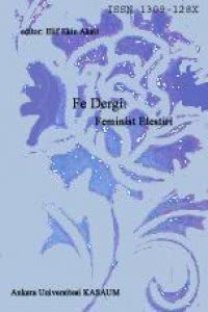The Awakening of the Locked Up Female Body in That Scorching Season of Youth
female body and sexuality, phallocentric discourse, de(con)struction, mind-body, unspoken
___
- Allen, Prudence. The Concept of Woman: The Aristotelian Revolution 750 BC-AD 1250. (Toronto: Eden Press, 1985).
- Ardener, Edwin. “Belief and the Problem of Women”, Perceiving Women ed. Shirley Ardener (London: Malaby Press, 1975).
- Aristotle . Generation of Animals. Trans. A. J. Peck (Cambridge: Harvard University Press, 1943).
- Atasü, Erendiz . Gençliğin O Yakıcı Mevsimi (Ankara: Bilgi Yayınevi, 1999).
- Atasü, Erendiz . Bilinçle Beden Arasındaki Uzaklık (İstanbul: Everest Yayınları, 2009).
- Berktay, Fatmagül. Tek Tanrılı Dinler Karşısında Kadın (İstanbul: Metis, 1995).
- Cixous, Helene & Clement, Catherine. The Newly Born Woman, Trans. B. Wing (Manchester: Manchester University Press, 1986).
- Diquinzio, Patrice. The Impossibility of Motherhood: Feminism, Individualism, and The Problem of Mothering (New York: Routledge, 1999).
- 148 The Awakening of the Locked Up Female Body in That Scorching Season of Youth Direnç, Dilek. “Yurekli Yaratıcılıgın Buyuk ve Istıraplı Mucadelesi: Erendiz Atasu’nun Yazan Kadınları/Kadın Yazarları”, Erendiz Atasü Edebiyatı ed. Günseli Sönmez İşçi (İstanbul: Can, 2014), 83 – 103.
- Freud, Sigmund. Three Essays on the Theory of Sexuality. Trans. James Strachey (New York: Avon Books, 1971).
- Garber, Marjorie. Vested Interests: Cross-Dressing and Cultural Anxiety (London: Routledge, 1997).
- Gubar, Susan. “‘The Blank Page’ and the Issues of Female Creativity”, Writing and Sexual Difference ed. Elizabeth Abel (Chicago: The University of Chicago Press, 1980).
- Jaggar, Alison & Bordo, Susan. Gender/Body/Knowledge: Feminist Reconstructions of Being and Knowing (New Jersey: Rutgers University Press, 1989).
- Irigaray, Luce. This Sex Which Is Not One. Trans. Catherine Porter (New York: Cornell University Press, 1985).
- Irigaray, Luce. Luce Irigaray:Teaching (London: Continuum, 2008).
- Kamitsuka, Margaret D. “Toward a Feminist Portmodern and Postcolonial Interpretation of Sin”, The Journal of Religion 84, no. 2 (April 2004): 179-211 https://www.jstor.org/stable/10.1086/381210
- Kristeva, Julia. “The Subject in Process”, The Tel Quel Reader, eds.Patrick French and Roland- Francois Lack (London: Routledge, 1998), 133-178.
- Kolodny, Annette. “Unearthing Herstory: An Introduction”, The Ecocriticism Reader:Landmarks in Literary Ecology ed. C. Glotfelty & H. Fromm (Georgia: The University of Georgia Press, 1996), 171–181.
- Koyuncu, Nevin Yıldırım. “Bilincin Usuna Beden Duşunce: Bedende Yeşeren Bilinc”, Erendiz Atasü Edebiyatı ed. Günseli Sönmez İşçi (İstanbul: Can, 2014), 169-192.
- Menteşe, Oya Batum. “Kadın Dilinde Aşk: ‘Gençliğin O Yakıcı Mevsimi’” Varlık 12, no. 1119 (2000): 11-15.
- Omolade, Barbara. “Heart of Darkness”, Powers of Desire: The Politics of Sexuality ed. Ann Snitow and Christine Stansell (New York: Monthly Review Press, 1983), 350-367.
- Showalter, Elaine. “Feminist Criticism in the Wilderness”, Critical Inquiry 8, no. 2 (1981): 179-205.
- Stephen, Kylie. “The Legal Language of Rape: A Feminist Reconstruction of Rape” Letter. 19, no.5 (1994): 224-228.
- Yüksel, Ayşegül. “Erendiz Atasü: Karşıtların Gerilimi Üstünden Edebiyat Üretmek”, Erendiz Atasü Edebiyatı ed. Günseli Sönmez İşçi (İstanbul: Can, 2014), 39 – 48
- ISSN: 1309-128X
- Yayın Aralığı: Yılda 2 Sayı
- Başlangıç: 2008
- Yayıncı: Ankara Üniversitesi KASAUM
Benzeşen/Farkılaşan Çerçeveler: Türkiye’deki İslamcı Kadın STK’lar Örneği
Asuman Özgür KEYSAN, Zelal ÖZDEMİR
Kadın Psikolojik Güç Ölçeği: Ölçek Geliştirme Çalışması
Modern Yoganın Analizi: Cinsiyetlendirilmiş Bir Sosyal Alan
Kadınlık ve Erkekliğin Değişmeyen Halleri: Televizyon Dizilerinde Toplumsal Cinsiyet
Coğrafi Araştırma Yöntemlerinin Toplumsal Cinsiyet İlişkilerinin İncelenmesine Katkısı
Anneler Ne Yapar, Kızları Ne İster? İki Nesil Kadın Anlatılarında Bir Gecekondu Mahallesi
Contribution of Geographical Research Methods to the Study of Gender Relations
12 Eylül Romanında Birey: Erkekliğin Yeniden İnşası Açısından “Kusma Kulübü”nü Okumak
Kadın Bedeni ve Biyo-İktidar/Biyo-Politika Söylem Düzeni
Süryaniliğin Kadınların Aile Yaşamına Kültürel Yansıması: Midyat Örneği
